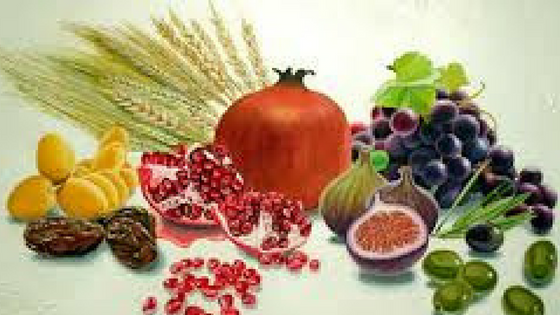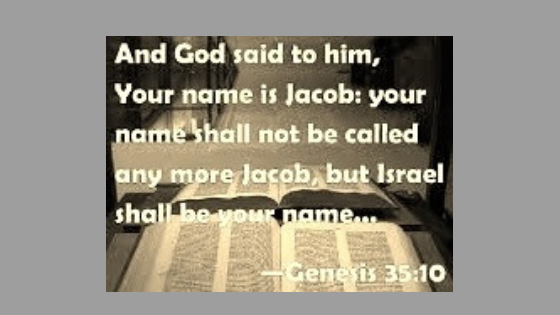Shabbat Table Talk
Parashat Eikev – Erev Shabbat 3 August 2018
Week of 29 July – 4 August 2018
Torah portion: Deuteronomy 7:12-11:25
Haftarah: Isaiah 49:14-51:3
Author: Mary Ann Payne
Download
The Israelites are camped east of Jericho on the plain of Moab, preparing to cross the Jordan and enter Canaan. Moses’ address to the people reminds us of a wise and loving father, as he extols the blessings of a ”good land”, and the seven species, …”a land of wheat and barley, of vines, figs and pomegranates, a land of olive trees and honey.” (Deut 8:7-8) In an impassioned plea, Moses warns of the danger of such plenty; that if the people forget the gifts of G_d’s goodness, they might forget G_d Himself. That seven species are named should not surprise us; seven being the number which denotes perfection/completion. In our day let us draw sustenance from these gifts through reflecting on each.
Wheat: The staff of life, a prized grain and cereal, a symbol of abundance. Wheat harvest is first mentioned in Gen 30:14. Scripture reports Isaac sowed seed and reaped a hundredfold (Gen 26:12).
Barley: Ruth (1:22) arrived in Bethlehem as the barley harvest began and gleaned in the fields behind the harvesters. In biblical times barley, not as valued as wheat, was often used for animal
fodder. Having less gluten than wheat it produced a heavier bread which was harder to digest.
Vines: Grapes, the fruit of the vine “Gladdens the heart” (Ps 104:15) and “Makes life merry.” (Ecc 10:19). Noah planted grapes after the flood (Gen 9:20) and also suffered the consequences of drinking
too much! Even with careful cultivation, it took five years for the first clusters of grapes to appear and ten years for a marketable crop. Viticulture was work for a settled people, not nomads and because
growing took so long, the cultivation of grapes became a symbol of peace.
Figs: The sugar in figs makes them a quick source of energy. (1 Sam: 30:12) Figs are dried and eaten on journeys, or pressed and squeezed into a cake. (1 Chron 12:40) The fig tree lent its name to two villages on the Mount of Olives: Bethphage, Beit Pagi (House of Unripe Figs) and Bethany, Beit Te’enah (House of the Fig). In (1 Kings 4:25) figs are seen as an image of tranquillity.
Pomegranates: It is said that the Talmud is as full of good deeds as the pomegranate is full of seeds. Pomegranates alternate with little gold bells to decorate the High Priest’s robe (Ex 28:33-34) and
adorn the capitals of the pillars at the doors of the Holy of Holies in Solomon’s Temple (1Kgs 7:18). Legend has it that King Solomon’s crown was fashioned after the pomegranate crown.
Olives: More than a food, olives and olive oil in particular, provided fuel for heat and light. Each day olive oil was offered to G_d in the tabernacle (Ex29:40), was used to anoint kings (1 Sam 10:1) and
priests (Ex 29:7) and as medicine (Is 1:6). Furniture was fashioned from olive wood and baskets woven from its slender branches. In Aramaic Gat Shamna means olive press. Gethsemane on the Mount of
Olives is named for the daytime toil of pressing olives. When evening came Gethsemane would be a quiet place where one might go pray.
Honey: Dates were the source of honey in biblical times. Date palms adorned Solomon’s Temple (1 Kgs 6:29) and often appear in synagogue decorations. Towering date palms need water to grow and were seen as a symbol of life and pointed to an oasis in the desert. Their fronds resemble a human
spine and serve as a reminder of the virtue of an upright character. Dates were stored up at Masada.
For Reflection:”Baruch Eloheinu she-achalnu mishelo uv’tuvo chayinu” “Praised be our G_d, of whose abundance we have eaten, and by whose goodness we live.”
Bibliography: Plaut, The Torah: A Modern Commentary, Vamosh, Food at the Time of the Bible – from Adam’s Apple to the Last Supper, Mishkan T’filah – A Reform Siddur
This week’s teaching commentary was prepared by
Mary Ann Payne, Melbourne, Australia, Bat Kol Alum 2007, 2011, 2015
mapayne77@gmail.com
[Copyright © 2018]
PLEASE NOTE: The weekly Parashah commentaries represent the research and creative thought of their authors, and are meant to
stimulate deeper thinking about the meaning of the Scriptures. While they draw upon the study methods and sources employed by the Bat Kol Institute, the views and conclusions expressed in these commentaries are solely those of their authors, and do not necessarily represent the views of Bat Kol. The commentaries, along with all materials published on the Bat Kol website, are copyrighted by the writers, and are made available for personal and group study, and local church purposes. Permission needed for other purposes. Questions, comments and feedback are always welcome.
Bat Kol Institute for Jewish Studies, Jerusalem
1983 -2018
“Christians Studying the Bible within its Jewish milieu, using Jewish Sources.”
Website: www.batkol.info Parashat Admin. gill@batkol.info



